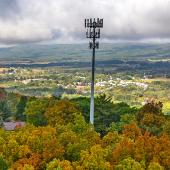One of the most memorable moments of Jeff Pierce’s 42-year career in South Dakota public safety communications occurred in his car on the way to a meeting. He was driving down the highway and found himself in the middle of a search for inmates who had escaped from a nearby prison and fled in a stolen vehicle.
Local law enforcement, the FBI, the state division of criminal investigation, a patrol helicopter, and others coordinated to apprehend the escapees hiding in a creek bed near the White River.
Pierce listened to their capture unfold over the statewide radio system that he had helped implement just a few years earlier.
“As they were all working together on the radio system to track those folks down, it really hit home about the importance of the communications system we put in place and why we did it,” he said. “It's one thing to talk about interoperability. It's another thing to actually experience it in a situation like that.”
A career advocating for interoperability
Pierce has served for decades as South Dakota’s statewide interoperability coordinator and engineering manager for the Bureau of Information and Telecommunications.
One of Pierce’s favorite parts of his job is working with first responders. “I don't think you get a true sense for working with public safety until you've done it, and then it's in your blood,” he said.
Now on the brink of retirement, Pierce has a special vantage point to look at the past, present, and future of public safety communications. No matter where he looks, he sees interoperability as a key part of public safety communications.
Crystals and vacuum tubes of the past
“When I first started, we still had equipment with vacuum tubes and crystals in it,” Pierce said, referring to components that once powered early radio communications. “The landscape was really different back then.”
When Pierce looks at the landscape of public safety communications in the 1960s to 1980s, he sees missteps as different agencies and jurisdictions pursued their own communication systems.
“What happened back then was everybody went their own direction for communications,” he said. He remembers that the highway patrol had a different radio system than the department of transportation or forestry division or other response agencies, making it difficult to work together.
As South Dakota experienced tornadoes, floods, fires, and other disasters that affected multiple jurisdictions and required multi-agency response, it became clear that everyone needed a better way to communicate with each other.
“Pulling South Dakota’s fractured public safety communications system back together was very painful and very expensive,” Pierce said. He overcame these challenges and worked together with other public safety leaders to implement a statewide public safety communications system for South Dakota; the system was fully operational beginning in 2003.
“Now they're all integrated into a common system. So there's been a lot of changes over the years in technology, processes, and how people think,” he said. “Requiring everyone to be interoperable across the board would have solved a lot of our communications problems.”
Broadband brought us to today
Today, the nationwide public safety broadband capabilities offered by FirstNet play a big role in public safety communications.
“FirstNet accelerated the pace of broadband being integrated into daily use by first responders,” Pierce said. “I think it was a wakeup call for first responders for how they can more efficiently operate.”
He believes FirstNet is a benefit to any first responder’s toolkit. “Broadband is a great complement to LMR [land mobile radio]. That could possibly be reversed at some point so LMR becomes the complement to broadband.”
As first responders use both broadband and LMR from their communications toolkit, Pierce remains staunch in his advocacy for interoperability.
“A big part of what we do right now is keep a mindset that our LMR picture needs to stay as integrated as possible,” he said. “And we're trying very hard not to repeat the mistakes of the past on the broadband side.” Those challenges are why FirstNet is interoperable across all jurisdictions and disciplines, no matter where in the country a user is responding.
One of the biggest advantages that Pierce sees for public safety broadband is better situational awareness. “The ability to get voice, video, pictures, reports, building plans, and other data directly to first responders in the field is a huge benefit,” he said.
The future is integrated
If Pierce had a crystal ball to see 40 years into the future of public safety communications, he thinks he would see more integration and interoperability.
“Whatever the future looks like, it'll be a more integrated picture,” he said. “I believe that the Internet of Things will factor more into the picture for first responders, PSAPs [public safety answering points], and citizens. Public-safety-grade devices will be more practical and better suited to daily use. Perhaps we’ll even be using low-Earth orbit satellites as backup.”
Public safety broadband will continue to be a driving force in the advancement of public safety communications. “Without the FirstNet program, we wouldn’t be anywhere close to where we are now,” said Pierce. “Everything I've seen has been the integration of LMR and broadband, and I think that will certainly continue.”
In June 2022, Pierce will retire from the world of public safety communications. “There's been a lot of progress made,” he said, reflecting back on his career, “But there's still a lot of progress to be made. I've got good people coming up to take on what I've done, and I feel confident that the next generation of public safety communications leaders will work to achieve seamless interoperability.”




















